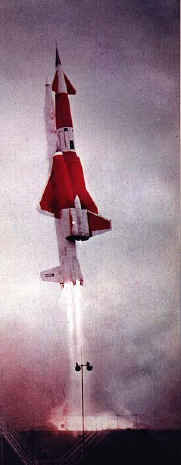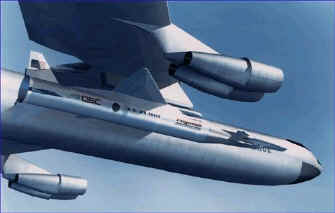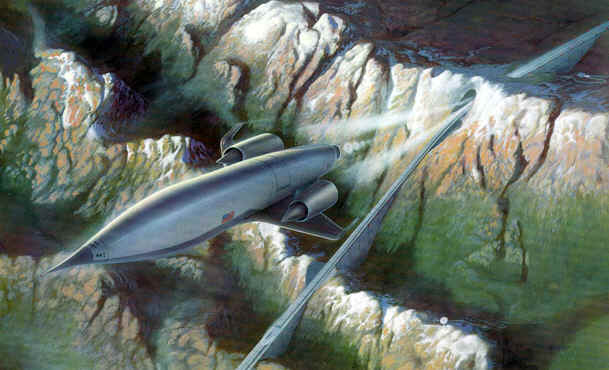SKY RAMP TECHNOLOGY
The North American B-64 "Navaho" (right) was designed as an interim strategic weapon in the 1950s while the first generation of Inter-Continental Ballistic Missiles (ICBM)s were perfected. The basic concept of the Navaho program called for the bomber to be lofted to high altitude using a conventional strap-on rocket booster. Since the XB-64 was powered by ramjets, the engines were started after launch when sufficient speed required for ramjet ignition was reached at approximately 50,000 feet.
SPECIFICATIONS (Booster and Navaho)
Length: 82 ft. 5 in.
Lift off thrust: approximately 405,000 lbs
PERFORMANCE
Maximum speed: Approx. Mach 3
Maximum range: 3,500 miles
Maximum altitude: 77,000 ft.
However, ICBMs were developed before
the Navaho began production, so the idea was scrapped. Limited ramjet engine research has continued
since they do not require a heavy turbine and can
achieve high speeds with their simple design. Since they suck
their own oxygen from the air, they are superior to rocket engines in the
atmosphere. The obvious problem is how to get the aircraft near mach for the ramjet to ignite from the incoming compressed air. The Navaho used a booster rocket
which proved expensive. Ramjets have been considered for spacecraft,
but if a rocket booster is used, the ramjets do not ignite until 50,000
feet and can only burn a minute before the atmosphere becomes too
thin to provide oxygen.
The obvious solution is a Sky Ramp, which
can propel a spacecraft to near mach for ramjet ignition. The ramjets
can then propel a spacecraft up to 100,000 feet and Mach 3-10 using oxygen
from the atmosphere for combustion rather than hauling its own liquid
oxygen. NASA is testing a modern scramjet engine (ramjets
which can fly over Mach 5 are called scramjets) the X-43A Hypersoar
aircraft (under-wing a B-52 at right) with hopes of achieving a top speed of
Mach 7-10. (click for more NASA
X-43A).
A Sky Ramp inclined track system can launch much larger X-43 type
scramjet aircraft at a far lower cost. Rocket
engines can provide the needed thrust, but a sled
using jet turbine engines can also do the job. The
F119 gas turbine jet engine used by the US Air Force F-22 fighter
produces 40,000lbs of thrust. Since
its two engines can propel that aircraft to Mach 2.5+, two or more engines
mounted on a sled can quickly propel an X-43 to the required speed for
scramjet ignition and launch from an inclined track.
A rocket-powered sled can launch large ramjet powered spacecraft. The ramjet engines could then efficiently accelerate the spacecraft to Mach 7 and 100,000 feet before it's rocket engines ignite. Since ramjet engines have no moving parts, they are simple and inexpensive. Dr. John R. Olds at Georgia Tech's Space Systems Design Lab has made several such proposals, including the rail launched "Argus" (right).
A sled will be essential to launch the proposed Blackswift hypersonic Global Range Recce/Strike Aircraft. If rail launched, it could take off from the USA and deliver payload to any point on the globe from an altitude and at a speed that would challenge current defensive measures and return to the US without the need for refueling or forward bases on foreign soil. Unmanned ramjet vehicles can be launched at high Gs from inexpensive short Sky Ramps built up smaller mountains. The Germans designed a similar ramp launched bomber during World War II, the "Sanger Amerika Bomber" (or Orbital Bomber, Antipodal Bomber or Atmosphere Skipper) which was designed for supersonic, stratospheric flight with rocket engines. These exciting options are other major advantages that Sky Ramps can provide.
©2008 Sky Ramp Technology